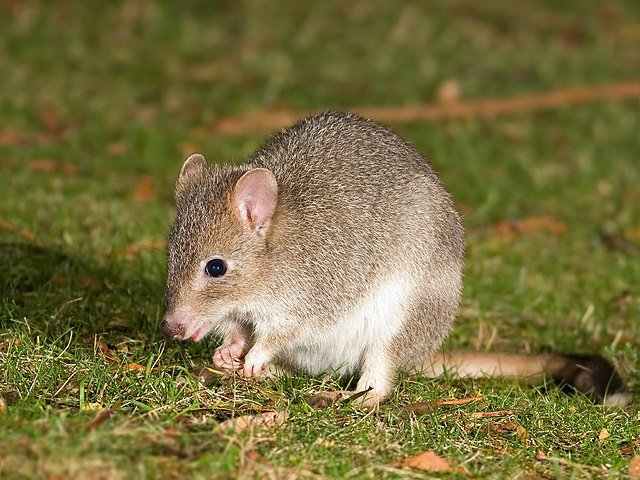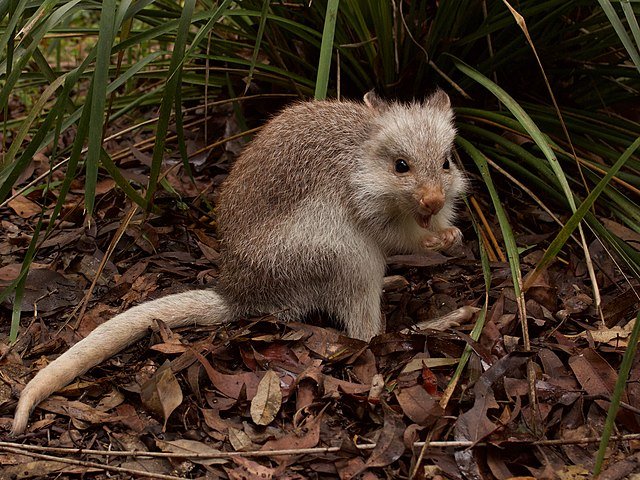Neither Rat Nor Roo
Photo by Mark Gillow, CC BY 2.0, via Wikimedia Commons / Expanded from original
Potoroidae
by Inspector Barry Mins on December 12, 2023Hey kids, welcome back to our series on the mysteries of created kinds. Last week, we met a colorful snake kind. This week, we leave South America behind and move to the outback of Australia, looking for a small kind of hopping marsupial.

Members of this kind are the first we have discussed to be mycophagous, that is when an animal likes to eat mushrooms and other fungi. Because the majority of most fungi is underground, the members of this kind are capable diggers. One species can excavate a buried fungus in an average of 2.4 seconds!1 They will eat other things too depending on the time of year, such as plants, fruits, and the odd invertebrate.2 Other members of this kind have a broader diet, including plants and insects, but still eat lots of fungi.3 In fact, they eat so many fungi, that they serve as critical agents of spreading the fungal spores needed for new populations of fungi to grow.4 If there are enough of these little marsupials in an area, they can do significant damage to the vegetation.5 Past Australian farmers regarded them as pests that ate their crops.
Members of this kind tend to prefer forested habitats.6 They are at least somewhat active at night, preferring areas with canopy and vegetation cover.7 Because they dig obsessively, several species in this kind are called ecosystem engineers, species that help modify their habitat.8 They hop in much the same way as kangaroos and wallabies.9
Has anyone figured it out yet? This week’s kind is the Potoroidae—the rat kangaroo kind. Stay tuned for next week when we will look for a kind known for their distinctive ears and tails.
Try out this fun word search!
Clue
Your clue for the week is:
This kind is invasive in Australia and competes with the rat kangaroos for vegetation.
Ask a Question
Have you ever had a question about created kinds but didn’t know who to ask? Have you ever wanted to learn more about your favorite kind? Well, now you can! You can ask me, Inspector Barry Mins, a question! Have your parents help you fill out this form, and you might get your question answered in my column! If you have any questions about created kinds, feel free to send them my way!
Footnotes
- Karl Vernes and Peter Jarman, “Long-Nosed Potoroo (Potorous tridactylus) Behavior and Handling Time When Foraging for Buried Truffles,” Australian Mammalogy 36, no. 1 (March 2014): 128–130, https://www.researchgate.net/profile/Karl-Vernes/publication/264458132_Long-nosed_potoroo_Potorous_tridactylus_behaviour_and_handling_times_when_foraging_for_buried_truffles/links/53e019f10cf2a768e49f5825/Long-nosed-potoroo-Potorous-tridactylus-behaviour-and-handling-times-when-foraging-for-buried-truffles.pdf.
- Robert J. Taylor, “Seasonal Changes in the Diet of the Tasmanian Bettong (Bettongia gaimardi), a Mycophagous Marsupial,” Journal of Mammalogy 73, no. 2 (May 1992): 408–414, https://academic.oup.com/jmammal/article-abstract/73/2/408/1108427.
- J. Bice and K. Moseby, “Diets of the Re-Introduced Greater Bilby (Macrotis lagotis) and Burrowing Bettong (Bettongia lesueur) in the Arid Recovery Reserve, Northern South Australia,” Australian Mammalogy 30, no. 1 (2008): 1–12, https://www.researchgate.net/profile/Katherine-Moseby/publication/263004438_Diets_of_the_re-introduced_greater_bilby_Macrotis_lagotis_and_burrowing_bettong_Bettongia_lesueur_in_the_Arid_Recovery_Reserve_Northern_South_Australia/links/55dcfa7208aeb41644aed0c1/Diets-of-the-re-introduced-greater-bilby-Macrotis-lagotis-and-burrowing-bettong-Bettongia-lesueur-in-the-Arid-Recovery-Reserve-Northern-South-Australia.pdf.
- Susan Nuske, Sten Anslan, Leho Tedersoo, Mark Bonner, Brad Congdon, and Sandra Abell, “The Endangered Northern Bettong, Bettongia tropica, Performs a Unique and Potentially Irreplaceable Dispersal Role for Truffle Ectomycorrhizal Fungi,” Molecular Ecology 27, no. 3 (2018): 4960–4971, https://researchonline.jcu.edu.au/55743/1/JCU_55743_Nuske_et_al-2018_Accepted.pdf.
- Grant Linley, Katherine Moseby, and David Paton, “Vegetation Damage Caused by High Densities of Burrowing Bettongs (Bettongia lesueur) at Arid Recovery,” Australian Mammalogy 39, no. 1 (May 2016): 33–41, https://www.researchgate.net/profile/Grant-Linley-2/publication/305789868_Vegetation_damage_caused_by_high_densities_of_burrowing_bettongs_Bettongia_lesueur_at_Arid_Recovery/links/5a31dda1a6fdcc9b2d92f3e6/Vegetation-damage-caused-by-high-densities-of-burrowing-bettongs-Bettongia-lesueur-at-Arid-Recovery.pdf.
- Randy Rose, “The Habitat, Distribution and Conservation Status of the Tasmanian Bettong, Bettongia-Gaimardi (Desmarest),” Australian Wildlife Research 13, no. 1 (1986): 1–6, https://www.researchgate.net/profile/Randy-Rose-3/publication/242416626_The_Habitat_Distribution_and_Conservation_Status_of_the_Tasmanian_Bettong_Bettongia-Gaimardi_Desmarest/links/0deec53292ee3792ef000000/The-Habitat-Distribution-and-Conservation-Status-of-the-Tasmanian-Bettong-Bettongia-Gaimardi-Desmarest.pdf.
- Graeme Finlayson, Theresa Pizzuto, Matthew Crowther, and Christopher Dickman, “Microhabitat Use by the Brush-Tailed Bettong (Bettongia penicillata) and Burrowing Bettong (B. lesueur) in Semiarid New South Wales: Implications for Reintroduction Programs,” Wildlife Research 34, no. 4 (July 2007): 271–279, https://www.researchgate.net/profile/Graeme-Finlayson/publication/52005002_Microhabitat_use_by_the_brush-tailed_bettong_Bettongia_penicillata_and_burrowing_bettong_B_lesueur_in_semiarid_New_South_Wales_Implications_for_reintroduction_programs/links/53d039d80cf2f7e53cfb71c7/Microhabitat-use-by-the-brush-tailed-bettong-Bettongia-penicillata-and-burrowing-bettong-B-lesueur-in-semiarid-New-South-Wales-Implications-for-reintroduction-programs.pdf.
- Michael Bunce, Dalal Haouchar, Carlo Pacioni, James Haile, Matthew McDowell, Alexander Baynes, Matthew Phillips, Jeremy Austin, and Lisa Pope, “Ancient DNA Reveals Complexity in the Evolutionary History and Taxonomy of the Endangered Australian Brush-Tailed Bettongs (Bettongia: Marsupialia: Macropodidae: Potoroinae),” Biodiversity and Conservation 25 (2016): 2907–2927, https://link.springer.com/article/10.1007/s10531-016-1210-y.
- Terence Dawson and Koa Webster, “Locomotion Energetics and Gait Characteristics of a Rat-Kangaroo Bettongia penicillate, Have Some Kangaroo-like Features,” Journal of Comparative Physiology B. 173 (2003): 549–557, https://www.researchgate.net/profile/Terence-Dawson/publication/10624802_Locomotion_energetics_and_gait_characteristics_of_a_rat-kangaroo_Bettongia_penicillata_have_some_kangaroo-like_features/links/0046351bfa3319f646000000/Locomotion-energetics-and-gait-characteristics-of-a-rat-kangaroo-Bettongia-penicillata-have-some-kangaroo-like-features.pdf.
- © 2024 Answers in Genesis
- Privacy Policy
- Contact
- About



